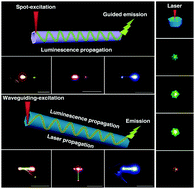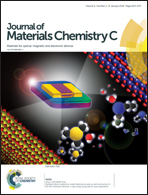Spatial control of upconversion emission in a single fluoride microcrystal via the excitation mode and native interference effect†
Abstract
Lanthanide (Ln)-doped upconversion (UC) micro/nanomaterials have attracted significant attention in various applications. However, spatial control of UC emission from micro/nanomaterials has not been developed to date due to the ineffective quantum yield and weak luminescence intensity. In this study, the fascinating luminescent patterns, including a dual-colour dumbbell, sunflower, rod-shaped candy, dichroic plate, and coloured ring from a series of single NaYF4:Yb/Ln (Ln = Er, Ho, and Tm) microcrystals, that exhibit different distinctive distributions on luminescence intensity and colour in space are obtained by varying the excitation modes. The overall integral UC intensity of a single microtube by waveguiding-excitation is invariably stronger relative to that in the case of the spot-excitation approach, and the enhancement factor increases 10 times. We explained the underlying physical mechanisms behind the changes in the colour and intensity of the luminescent pattern based on the native diffraction and interference effect of microcrystals. These findings provide a new way to improve UC luminescence and facilitate a basic understanding of the use of UC micro/nanocrystals as natural interference devices, which will result in new applications in displays, optical waveguides, and anti-counterfeiting.



 Please wait while we load your content...
Please wait while we load your content...